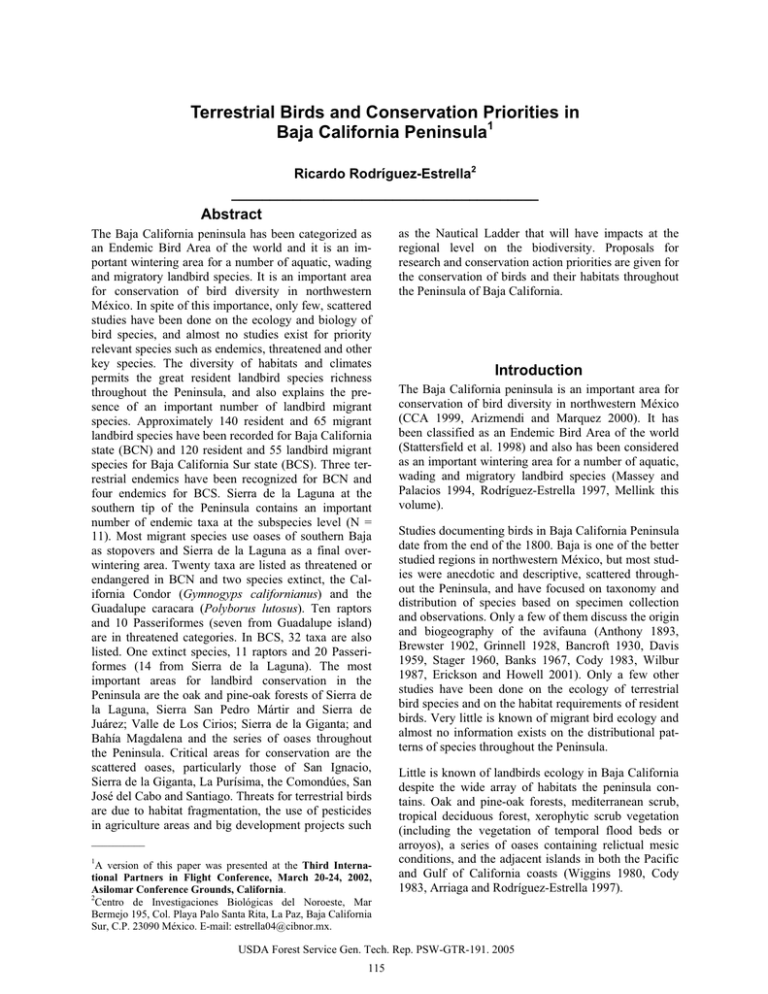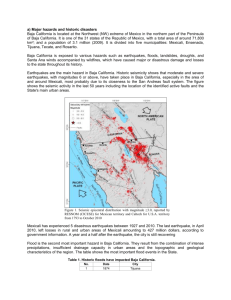Terrestrial Birds and Conservation Priorities in Baja California Peninsula Abstract Ricardo Rodríguez-Estrella
advertisement

Terrestrial Birds and Conservation Priorities in Baja California Peninsula1 Ricardo Rodríguez-Estrella2 ________________________________________ Abstract The Baja California peninsula has been categorized as an Endemic Bird Area of the world and it is an important wintering area for a number of aquatic, wading and migratory landbird species. It is an important area for conservation of bird diversity in northwestern México. In spite of this importance, only few, scattered studies have been done on the ecology and biology of bird species, and almost no studies exist for priority relevant species such as endemics, threatened and other key species. The diversity of habitats and climates permits the great resident landbird species richness throughout the Peninsula, and also explains the presence of an important number of landbird migrant species. Approximately 140 resident and 65 migrant landbird species have been recorded for Baja California state (BCN) and 120 resident and 55 landbird migrant species for Baja California Sur state (BCS). Three terrestrial endemics have been recognized for BCN and four endemics for BCS. Sierra de la Laguna at the southern tip of the Peninsula contains an important number of endemic taxa at the subspecies level (N = 11). Most migrant species use oases of southern Baja as stopovers and Sierra de la Laguna as a final overwintering area. Twenty taxa are listed as threatened or endangered in BCN and two species extinct, the California Condor (Gymnogyps californianus) and the Guadalupe caracara (Polyborus lutosus). Ten raptors and 10 Passeriformes (seven from Guadalupe island) are in threatened categories. In BCS, 32 taxa are also listed. One extinct species, 11 raptors and 20 Passeriformes (14 from Sierra de la Laguna). The most important areas for landbird conservation in the Peninsula are the oak and pine-oak forests of Sierra de la Laguna, Sierra San Pedro Mártir and Sierra de Juárez; Valle de Los Cirios; Sierra de la Giganta; and Bahía Magdalena and the series of oases throughout the Peninsula. Critical areas for conservation are the scattered oases, particularly those of San Ignacio, Sierra de la Giganta, La Purísima, the Comondúes, San José del Cabo and Santiago. Threats for terrestrial birds are due to habitat fragmentation, the use of pesticides in agriculture areas and big development projects such __________ 1 A version of this paper was presented at the Third International Partners in Flight Conference, March 20-24, 2002, Asilomar Conference Grounds, California. 2 Centro de Investigaciones Biológicas del Noroeste, Mar Bermejo 195, Col. Playa Palo Santa Rita, La Paz, Baja California Sur, C.P. 23090 México. E-mail: estrella04@cibnor.mx. as the Nautical Ladder that will have impacts at the regional level on the biodiversity. Proposals for research and conservation action priorities are given for the conservation of birds and their habitats throughout the Peninsula of Baja California. Introduction The Baja California peninsula is an important area for conservation of bird diversity in northwestern México (CCA 1999, Arizmendi and Marquez 2000). It has been classified as an Endemic Bird Area of the world (Stattersfield et al. 1998) and also has been considered as an important wintering area for a number of aquatic, wading and migratory landbird species (Massey and Palacios 1994, Rodríguez-Estrella 1997, Mellink this volume). Studies documenting birds in Baja California Peninsula date from the end of the 1800. Baja is one of the better studied regions in northwestern México, but most studies were anecdotic and descriptive, scattered throughout the Peninsula, and have focused on taxonomy and distribution of species based on specimen collection and observations. Only a few of them discuss the origin and biogeography of the avifauna (Anthony 1893, Brewster 1902, Grinnell 1928, Bancroft 1930, Davis 1959, Stager 1960, Banks 1967, Cody 1983, Wilbur 1987, Erickson and Howell 2001). Only a few other studies have been done on the ecology of terrestrial bird species and on the habitat requirements of resident birds. Very little is known of migrant bird ecology and almost no information exists on the distributional patterns of species throughout the Peninsula. Little is known of landbirds ecology in Baja California despite the wide array of habitats the peninsula contains. Oak and pine-oak forests, mediterranean scrub, tropical deciduous forest, xerophytic scrub vegetation (including the vegetation of temporal flood beds or arroyos), a series of oases containing relictual mesic conditions, and the adjacent islands in both the Pacific and Gulf of California coasts (Wiggins 1980, Cody 1983, Arriaga and Rodríguez-Estrella 1997). USDA Forest Service Gen. Tech. Rep. PSW-GTR-191. 2005 115 Landbirds Conservation in Baja California – Rodríguez-Estrella There are only a few papers dealing with productivity, diet, and breeding biology of several bird species and almost no information on the habitat requirements, habitat use and habitat selection of resident birds, winter or migrant ecology (see Wilbur 1987; Rodríguez-Estrella et al. 1997, 1998, in press). Finally, almost no information exists on the distributional patterns of birds among important bird areas, hotspots and critical areas. vegetation is dominated by Abronia maritima, Jouvea pilosa, Sporobolus virginicus and Maytenus phyllantoides (Delgadillo 1992, Rodríguez-Estrella et al. 1999, León de la Luz et al. 2000). Characteristics of the Baja California Peninsula The Baja California Peninsula contains 12 Priority Terrestrial Areas (Arriaga et al. 2000). These areas are contained into the Sierra de la Laguna, Sierra El Mechudo, Sierra de la Giganta, Planicies de Magdalena, El Vizcaíno-El Barril, Sierras La Libertad-La Asamblea, Valle de los Cirios, San Telmo-San Quintín, Punta Banda-Eréndira, Santa María-El Descanso, Sierra San Pedro Mártir and Sierra de Juárez (fig. 1). The length of the peninsula is about 1300 km, and the width ranges 30-80 km. Coastal plains, deep canyons and rough mountains can be found throughout the Peninsula. Vegetation types include xerophitic scrub, pineoak forests, Mediterranean scrub chaparral, tropical deciduous forest, coastal vegetation, mesic vegetation in oases with palms, reed grass, and Typha. The altitude ranges between 0 and 3100 m. Mean annual precipitation ranges from 100 mm in Vizcaino desert to more than 765 mm in Sierra de la Laguna. Dominant plants are columnar giant cardon cacti (Pachycereus spp.), mesquite (Prosopis spp.), palo verde (Cercidium microphyllum), plum tree (Cyrtocarpa edulis), lomboy (Jatropha spp.), copal (Bursera spp.), dagger cactus (Stenocereus gummosus), Adam’s tree (Fouquieria diguetii), Cirio (Fouquieria columnaris), ruellia (Ruellia peninsularis), and cholla (Opuntia cholla) in scrub vegetation. The mesic vegetation of oases is dominated by palms (Washingtonia robusta, Phoenix dactylifera), reed-grass (Phragmites communis), and clumps of cattails (Typha domingensis) associated with the water’s edge or freshwater marshes. Pine-oak forests are dominated by pines (Pinus spp.), oaks (Quercus spp.), and manzanita (Arbutus peninsularis). Tropical deciduous forest is dominated by Lysiloma divaricata, Albizzia occidentalis, Jatropha cinerea, Tecoma stans, Cassia emarginata and Pithecellobium undulatum. Mediterranean scrub vegetation or chaparral contains Archillea millefolium, Adenostoma fasciculatum, Adiantum jordanii, Aesculus parriyi, Baccharis sarathroides, Camissonia lewssi, Ephedra californica, Daucus pusillus, Mimulus aridus, Dryopteris arguta, and Hemizonia fasciculata. Coastal Figure 1—The Baja California Peninsula priority and critical terrestrial areas (A), and the most relevant oases locations (B). Urbanization, agriculture and ranching, tourism and mining are the main human activities in the area. Baja California has the lowest human density of all of México and most natural vegetation in middle and south Baja California is disturbed mostly by grazing. Threats for oases have been determined to be tourism, burning reed-grass and palm vegetation to eliminate dry vegetation so as to avoid fires, cutting stems of reed grass for rural home construction, human water use, and cattle, horses and burros feeding on reed grass USDA Forest Service Gen. Tech. Rep. PSW-GTR-191. 2005 116 Landbirds Conservation in Baja California – Rodríguez-Estrella (Rodríguez-Estrella et al. 1999). Mesquite wood extraction was the main threat we detected in arroyo habitat. The use of pesticides presents a serious threat on most agriculture land. Common pesticides are DDT and PCBs (Merino et al. 2002). (N = 11), as a result of its particular geological and evolutionary history (Rodríguez-Estrella 1988). Most migrant species use oases of southern Baja as stopovers (Rodríguez-Estrella et al. 1997), and Sierra de la Laguna as a final overwintering area (RodríguezEstrella, unpubl. data1) (fig. 1). Official Natural Protected Areas Baja California Peninsula contains several protected areas (INE 2002). The most important in terms of size are those of Vizcaino desert Biosphere Reserve and Valle de Los Cirios National Park, both comprising more than 4,000,000 ha. Sierra de La Laguna Biosphere Reserve is the most important protected area in terms of number of endemic taxa (fig. 1). Sierra de La Laguna is an important relict area because it is the only area in south Baja California containing oak and pineoak forests, and has been isolated since the Miocene (Rodríguez-Estrella 1988). Several birds, reptiles and small mammal species have been isolated since then and have high levels of endemism (Rodríguez-Estrella 1988, Cancino et al. 1994). Status of Birds There are 20 taxa listed as threatened or endangered and extinct species in BCN (NOM 2001). Two species are extinct, the California Condor (Gymnogyps californianus, extinct in the wild but recently reintroduced) and the Guadalupe Caracara (Polyborus lutosus). Ten raptors and 10 Passeriformes are threatened. Seven of the Passeriformes are from Guadalupe island. In BCS, 32 taxa are listed: the Groove-billed Ani (Crotophaga sulcirostris pallidula) is extirpated since early 1900 from the Cape region (Grinnell 1928), and 11 raptors and 20 Passeriformes (14 from Sierra de la Laguna) are officially listed (NOM 2001). Bird Species Diversity Baja California Peninsula is divided geopolitically in the Baja California (BCN) and Baja California Sur (BCS) states. Approximately 140 resident and 65 migrant species has been recorded for BCN. There are three endemics in BCN, the Guadalupe Junco (Junco insularis), Mountain chickadee (Poecile gambeli) in Sierra Juárez and Sierra San Pedro Mártir, and the Guadalupe Caracara (Polyborus lutosus) which is extinct (Ceballos and Marquez 2000). For BCS, 120 resident and 55 migrant species have been recorded. There are four terrestrial endemics in BCS, the Belding’s Yellowthroat (Geothlypis beldingi; endemic to particular oases of Baja California Sur; RodríguezEstrella et al. 1999), Xantus’ Hummingbird (Hylocharis xantusii; originally endemic to Sierra de la Laguna and subsequently colonizing most of the Peninsula, mainly in mesic vegetation, canyons, and islands habitats), Gray Thrasher (Toxostoma cinereum; endemic to scrub vegetation in BCS and part of BCN), and the Cape Pygmy-Owl (Glaucidium hoskinsii; endemic to Sierra de la Laguna following Howell and Webb 1995, Stattersfield et al. 1998). The San Lucas Robin taxonomic status is now considered a subspecies endemic to the mountain pine forests of Sierra de la Laguna by all modern authorities (Turdus migratorius confinis AOU 1998, Stattersfield et al. 1998) contrary to some authorities that considered this bird as an endemic species in the past (e.g. Turdus confinis). Sierra de la Laguna at the southern tip of the Peninsula contains the most endemic taxa at the subspecies level Important Areas for Bird Conservation We can propose that the most important areas for bird conservation in Baja California Peninsula are the oak and oak-pine forests of Sierra de la Laguna and Sierra San Pedro Mártir and Sierra de Juárez; Valle de Los Cirios; Sierra de la Giganta; and Bahía Magdalena (because the only breeding Bald Eagle population in Baja California is present here) and the series of oases throughout the Peninsula (Fig. 1). Most endemic and priority species, and a high species richness have been recorded in those areas. Critical areas for conservation are the scattered oases, particularly those of San Ignacio, Sierra de la Giganta, La Purísima, the Comondúes, San José del Cabo and Santiago (Rodríguez-Estrella et al. in press) used as stopovers by a significant number of migrant bird species. An important number of oases are critically threatened (Rodríguez-Estrella et al. 1999). Oases contain the highest species richness and diversity of all habitats. Also, the highest bird abundances have been recorded at oases. Oases seem to be attractive habitats for birds, both residents and migrants (see RodríguezEstrella et al. 1997a). Oases represent small gaps of rich habitats inserted in the adjacent arid regions of Baja California that contain xerophythic scrub vegetation. Also, field crops and golf courses are intensively used by resident and migrant birds in Baja California USDA Forest Service Gen. Tech. Rep. PSW-GTR-191. 2005 117 Landbirds Conservation in Baja California – Rodríguez-Estrella Peninsula (Rodríguez-Estrella 1997; RodríguezEstrella, A. Cota, and R. BolaĖos, unpubl. data2). Threats to Birds The main threats for birds in Baja California are increasing urbanization and tourism development, and agriculture, grazing and mining activity with resulting habitat loss. The development of the Nautical Ladder Route (Escalera Náutica; http://www.bajaquest.com/ escaleranautica/) will certainly represent a change at the regional scale and a major threat for biodiversity conservation. The plan includes the development of buildings, roads and small airports in many areas of Baja that will increase the traffic and permit people to easily arrive to areas inaccessible before. Thus, it is expected human activity will increase threats to birds mainly because of habitat changes and disturbance. On the other hand, agriculture and the use of organochlorines and organophosphates pesticides (e.g. DDT, DDE, PCBs, Malathion) are among the most serious threats to bird populations and functional ecosystems. Proposals and Perspectives for Research and Conservation I propose the next research could be conducted in Baja California Peninsula to correctly establish management plans for the conservation of landbird diversity: x Research on changes in landbird distributional patterns due to habitat transformation by human activity (as field crops, urbanization, golf courses) is urgently needed. Habitat changes will influence the presence and abundance of many bird species, some of them will benefit from these changes while others will be negatively affected. It is important to establish the native species that are currently being affected with the still moderate habitat changes. x Research on habitat use and habitat selection of endemics, rare and other key species in critical areas is urgently needed because these species are crucial in biodiversity conservation strategies. x Research on changes of functional systems with the introduction of non native species. Alien species (e.g. predators) are known to produce functional systems changes and could reduce population size of other species until extinction. __________ 1 unpublished data on file at CIBNOR, La Paz, Baja California Sur, México. 2 unpublished data on file at CIBNOR, La Paz, Baja California Sur, México. x Research on the effects of habitat changes on colonization rates of highly successful invasive species. Also, to evaluate the effects of these species on the bird community structure and its dynamics. For example, the European Starling (Sturnus vulgaris) is an aggressive and highly competitive species for cavity nesting birds as woodpeckers and small owls in the desert (Kerpez and Smith 1990, Ingold 1994). The Bronzed Cowbird (Molothrus ater) can parasitize nests of small passerines. Both species have increased their distribution in the Baja California Peninsula and are now breeding throughout the peninsula (Wilbur 1987, Rodríguez-Estrella et al. 1997b). x Research on the effects of habitat changes of oases on migrant birds as they use them as stopovers and are key habitats during the migration process. x Research on sub-lethal effects of toxic chemicals used in agriculture (i.e. organochlorine contaminants) on bird individuals and at the population level. It is well known that some toxic chemicals, in particular organochlorines, have the ability to interfere with the development of the reproductive, endocrine, immune and nervous systems of embryos. It has been reported in many studies the decline of bird populations due to the increase in the use of chemical pesticides (Safford and Jones 1997). x To determine the natural and man-made variables influencing the presence of key bird species at the regional scale through spatial analysis. There are several ways landbird conservation priorities in Baja California Peninsula could be implemented. First, it is needed to convince governmental authorities about the need to protect particular areas for landbird conservation showing a documented analysis of social and economic benefits using alternative activities as for example ecotourism. Environmental education can play an important role for this purpose. Second, it is needed to find ways for local people to continue the use of natural resources without making strong impacts, particularly in fragile and critical systems such as oases; or secure funds to pay for the non-use of these particular resources in the long-term. Third, use legal mechanisms to prohibit the use of persistent pesticides (i.e. organochlorines) in agriculture lands, and enhance the use of alternative non-toxic, non-persistent, pest controls. Fourth, involve golf course investors in conservation activities through agreements for developing habitat improvements for birds as is happening in many places in the United States (Gillihan 2000). Finally, it is clearly urgent to establish a plan for ecological restoration and detoxification of critical areas. USDA Forest Service Gen. Tech. Rep. PSW-GTR-191. 2005 118 Landbirds Conservation in Baja California – Rodríguez-Estrella The indicators of the success of the conservation actions could be: 1. maintenance of habitat suitability in the long-term; 2. increase population viability of species of concern; 3. maintenance of functional and healthy biological systems; 4. increase the concern of the human population and their support for conservation activities. An important mechanism to assure the success of conservation actions will be surely the establishment of specific legal laws for conservation or protection of critical habitats and hotspots in Baja California Peninsula. Priorities for landbird conservation actions should be established. I propose that the most priority conservation actions in Baja that should be immediately initiated are: 1. protect and preserve oases; 2. eliminate the use of pesticides in agriculture lands; and 3. protect bird migratory routes throughout Baja peninsula. Acknowledgments I thank the Partners in Flight 2002 meeting organizers for the invitation to attend the meeting and for financial support. B. Granados and L. Rivera for help with the presentation. T. Rich, E. Palacios and E. Mellink for helpful comments to a first draft. Consejo Nacional de Ciencia y Tecnología (México), SEMARNATCONACYT, 2002-318, and Centro de Investigaciones Biológicas del Noroeste gave financial support during the writing of this paper. Bancroft, G. 1930. The breeding birds of central Lower California. Condor 32: 20-49. Banks, R. C. 1967. Birds and mammals of La Laguna, Baja California. Transactions of the San Diego Society of Natural History 14: 205-232. Brewster, W. 1902. Birds of the Cape region of Lower California. Bulletin of the Museum of Comparative Zoology 41: 1-241. Cancino, J., F. Salinas, Y. Maya, R. Coria, J. L. León, R. Rodríguez-Estrella, R. Aguilar and L. Arriaga. 1994. Contexto local. In: L. Arriaga, editor. Estrategia para el manejo y protección legal de la Sierra de La Laguna. Publication No. 6. La Paz, B.C.S. México: Centro de Investigaciones Biológicas del Noroeste; 41-60. Ceballos, G. and L. V. Márquez. 2000. Las aves de México en peligro de extinción. México: CONABIO-UNAM-Fondo de Cultura Económica; 430 p. Cody, M. L. 1983. The land birds. In: T. J. Case, and M. L. Cody, editors. Island biogeography of the Sea of Cortez. Berkeley, CA: University of California Press; 210-245. Comisión para la Cooperación Ambiental (CCA). 1999. Areas importantes para la conservación de las aves de América del Norte. Directorio de 150 sitios relevantes. Québec, Canada: CCA Publications; 369 p. Davis, J. 1959. The Sierra Madrean element of the avifauna of the Cape district, Baja California, México. Condor 61: 75-84. Delgadillo J. 1992. Florística y Ecología del Norte de Baja California. Ensenada: Universidad Autónoma de Baja California, México; 339 p. Ph.D. Dissertation. Erickson, R. A., and S. N. G. Howell, editors. 2001. Birds of Baja California: Status, distribution, and taxonomy. American Birding Association. Monographs in Field Ornithology No. 3. Gillihan, S. W. 2000. Bird conservation on golf courses. A design and management manual. Chelsea, MI: Ann Arbor Press; 335 p. Literature Cited American Ornithologists' Union (AOU). 1998. Check-List of North American Birds. 7th edition. Washington, DC: American Ornithologists' Union. Grinnell, J. 1928. A distributional summation of the ornithology of Lower California. University of California Publications of Zoology 32: 1-300. Anthony, A. W. 1893. Birds of San Pedro Mártir, Lower California. Zoe 4: 228-247. Howell S. N. G., and S. Webb. 1995. A guide to the birds of México and Northern Central America. Oxford, NY: Oxford University Press. Arizmendi, M. C., and L. V. Marquez, eds. 2000. Areas de importancia para la conservación de las aves en México. Ed. México, D.F.: CIPAMEX, 440 p. Arriaga, L., J. M. Espinoza, C. Aguilar, E. Martínez, L. Gómez and E. Loa, coordinators. 2000. Regiones terrestres prioritarias de México. México: Comisión Nacional para el Conocimiento y uso de la Biodiversidad. Arriaga, L., and R. Rodríguez-Estrella, editors. 1997. Los Oasis de la Península de Baja California. Publication 13. La Paz, B.C.S. México: Centro de Investigaciones Biológicas del Noroeste (CIBNOR), S.C.; 292 p. Instituto Naicional de Ecología (INE). 2002. Reservas de la Biosfera en México. Available at http://www.ine.gob. mx/. Ingold, D. J. 1994. Influence of nest-site competition between European Starlings and woodpeckers. Wilson Bulletin 106: 227-241. Kerpez, T. A., and N. S. Smith. 1990. Competition between European Starlings and native woodpeckers for nest cavities in saguaros. Auk 107: 367-375. USDA Forest Service Gen. Tech. Rep. PSW-GTR-191. 2005 119 Landbirds Conservation in Baja California – Rodríguez-Estrella León de la Luz, J. L., Pérez N. J., and A. Breceda. 2000. Vegetation of the lowlands of the Cape Region, Baja California Sur: A transitional xerophitic tropical plant community. Journal of Vegetation Science 11: 555-564. Massey, B. W., and E. Palacios. 1994. Avifauna of the wetlands of Baja California, México: Current status. Studies in Avian Biology 15: 45-57. Mellink, E. This volume. Current status of research on the shorebirds, marsh birds, and waders of the peninsula of Baja California. Merino, R., R. Rodríguez-Estrella, L. B. R. Rivera, E. Abad, J. Rivera, and B. Jiménez. 2002. Preliminary evaluation of organochlorine contaminants (PCDDs, PCDFs, PCBs and DDTs) in birds from Baja California, México. In: J. Rivera, editor. Organohalogen Compounds 59; 29-32. Norma Oficial Mexicana (NOM). 2001. NOM-059-ECOL2001. Protección ambiental-Especies nativas de México de Flora y Fauna silvestres-Categorías de riesgo y especificaciones para su inclusión, exclusión o cambioLista de especies en Riesgo. México, D.F.: Secretaría del Medio Ambiente y Recursos Naturales. Rodríguez-Estrella, R. 1988. Avifauna. In: L. Arriaga and A. Ortega, editors. La Sierra de la Laguna de Baja California Sur. Publication. No. 1. La Paz, B.C.S. México: Centro de Investigaciones Biológicas de B.C.S.; 185-208. Rodríguez-Estrella, R. 1997. Factores que condicionan la distribución y abundancia de las aves terrestres en Baja California Sur, México: El efecto de los cambios al hábitat por actividad humana. Madrid: Universidad Autónoma de Madrid, Spain. Ph.D. dissertation. Rodríguez-Estrella, R., L. Rubio, and E. Pineda. 1997a. Los oasis como parches atractivos para las aves residentes e invernantes. In: L. Arriaga and R. Rodríguez-Estrella, editors. Los oasis de la Península de Baja California. Publication No. 13, La Paz, B.C.S.: CIBNOR, S.C. ; 157195. Rodríguez-Estrella, R., J. Bustamante, and M. C. Blázquez. 1997b. European starlings nesting in southern Baja California, México. Wilson Bulletin 109: 535-539. Rodríguez-Estrella, R., J. A. Donázar, and F. Hiraldo. 1998. Raptors as indicators of environmental change in the scrub habitat of Baja California Sur, México. Conservation Biology 12: 921-925. Rodríguez-Estrella, R., L. Rubio, E. Pineda, and G. Blanco. 1999. The Belding's Yellowthroat: Current status, habitat preferences, and threats in oases of Baja California, México. Animal Conservation 2: 77-84. Rodríguez-Estrella, R., M. C. Blazquez, and J. M. Lobato. In press. Importance of arroyos and oases of Baja California for landbirds: Implications for conservation. In: J-L. Cartron and G. Ceballos, editors. Biodiversity, ecosystems, and conservation in northern México. Oxford University Press. Safford, R., and C. Jones. 1997. Did organochlorine pesticide use cause declines in Mauritian forest birds? Biodiversity and Conservation 6: 1445-1451. Stattersfield, A. J., M. J. Crosby, A. L. Long, and D. C. Wege. 1998. Endemic bird areas of the world. Birdlife Conservation. Series No. 7. Cambridge, UK: Birdlife International; 846 p. Stager, K. E. 1960. Baja California symposium: the composition and origin of the avifauna. Systematic Zoology 9: 179-183. Wiggins I. L. 1980. Flora of Baja California. Stanford, CA: Stanford University Press. Wilbur, S. R. 1987. Birds of Baja California. Berkeley, CA: University of California Press. USDA Forest Service Gen. Tech. Rep. PSW-GTR-191. 2005 120




